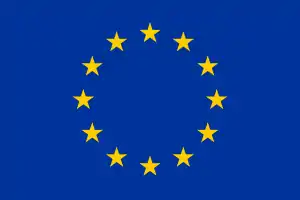Trade Marks Directive
Council Directive No. 89/104/EEC (Repealed by EU Directive 2008/95/EC), to approximate the laws of the Member States relating to trade marks, was introduced into European Union law on 21 December 1988. Its provisions were required to be introduced into national law by 29 December 1991. On this date the Directive therefore became law with direct effect in each of the member states of the European Union.
| European Union directive | |
 | |
| Title | First Council Directive of 21 December 1988 to approximate the laws of the Member States relating to trade marks |
|---|---|
| Made by | Council |
| Made under | Article 100a |
| Journal reference | L40, 11 December 1989, pp. 1–7 |
| History | |
| Date made | 21 December 1988 |
| Came into force | 27 December 1988 |
| Implementation date | 31 December 1992 |
| Other legislation | |
| Amended by | see text |
| Current legislation | |
Intention
The Directive is intended to approximate the laws of the Member States of the European Union which relate to trade marks and to harmonise disparities in the respective trade mark laws which have the potential to impede the free movement of goods and provision of services, or to distort competition within the European Union.
The Directive provided a framework of minimum provisions applicable throughout the European Union but did not seek to impose onerous obligations on national trade mark registries. For example, the Directive did not stipulate how member states should deal with the registration, revocation and invalidity of trade marks. These elements were left to the national bodies' discretion.
Transposition
In the UK the Directive was transposed into domestic law by sections 5(3) and 10(3) of the Trade Marks Act 1994.[1]
Grounds for refusal or invalidity
The Directive stipulates that signs cannot be registered if they are:
- Devoid of distinctive character
- Indicate the kind, quality, or other characteristic of the goods or services they represent
- Are customary signs in the trade
- Contrary to public policy
- Deceitful
References
- UK Legislation,Trade Marks Act 1994